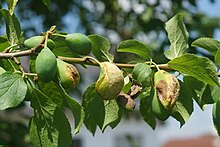Fool's disease of plums
The fool's disease (also: fool's pocket disease or pocket sickness ) is a contagious fungal disease of plums and plums.
Pathogen
This disease is caused by the fungus Taphrina pruni from the genus Taphrina (order Taphrinales ). The fungus mainly affects plums , bird cherries and apricots . Mirabelle plums and Renekloden can be infected, but are much more resistant to the disease.
Course of infection and symptoms of the disease
The fungus infects the ovaries during flowering. Cool and rainy weather during flowering encourages infection, while warm and dry weather inhibits it. Before the flowers can be fertilized, the fungus begins to grow in the ovary, which stimulates the formation of the characteristic pockets. Finally, a white mycelium appears on the surface of the infected fruit, from which the shoots of the tree, on which the fungus overwinters, are colonized. During the time when there are no fruits on the tree, the saprobion table lives on the shoots and in the buds.
The first symptoms of the infected fruits are already visible shortly after flowering. The infected fruits develop faster than unaffected fruits; elongated, often curved structures are created. The reason for this is a plant hormone produced by the fungus ( indolyl acetic acid ). The fruits appear pod-shaped with an initially smooth and light green surface, which then becomes wrinkled and yellowish. Since no core develops, the infected fruits are hollow inside, from which the name “pocket disease” is derived. Finally, the mycelium becomes visible as a white coating on the surface of the fruit. The ascospores can be seen microscopically here.
The flesh of infected fruits is green, hard and without juice. The malformed fruits, which are also known as hunger plums or plums, fool's pockets or cobbler plums, turn brown over time, shrink or begin to rot and usually fall off soon, so that disease can lead to significant harvest losses.
Leaves and shoots are only rarely affected by the disease, which then show abnormal growth such as thickening and curvatures.
origin of the name
There are different explanations regarding the origin of the name. One theory says that the name is derived from the "crazy" looking fruits ("fools"). According to another theory, the name comes from the fact that the disease cannot be seen in the fruits for a relatively long time. The fruits make a fool of you.
literature
- Pocket sickness. In: Brockhaus Encyclopedia. 19th, completely revised edition. Volume 21, Mannheim 1993, p. 641.



